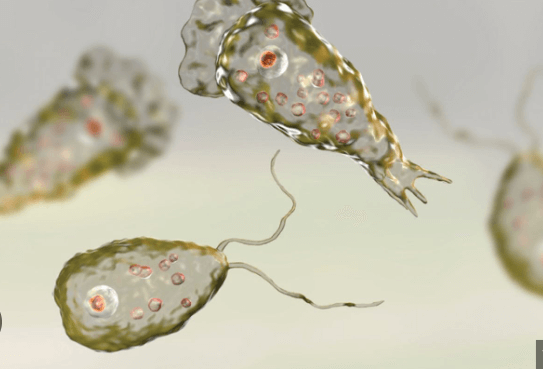Diving into the depths of water-related illnesses, one name that often sends shivers down our spines is Naegleria. This microscopic organism has gained notoriety for its rare but devastating effects on the human brain. But what exactly is it? How does it spread, and what are the symptoms to watch out for? In this blog post, we’ll delve into all things Naegleria – from prevention tips to treatment options – so you can arm yourself with knowledge and stay safe when enjoying your favorite aquatic activities. So let’s dive right in!
Read also It’s Cool When They Do It
What is Naegleria?
It is a single-celled organism that belongs to the group of amoebas. It’s commonly found in warm freshwater environments such as lakes, hot springs, and untreated swimming pools. This tiny creature may seem harmless at first glance, but it has the potential to cause serious health issues.
When it enter the human body through the nose, typically during activities like swimming or diving in infected water sources, it can travel up to the brain causing a rare but severe infection known as primary amebic meningoencephalitis (PAM). Once in the brain, this microscopic menace starts multiplying rapidly and attacking healthy brain tissue.
It’s important to note that it’s infection are extremely rare. In fact, they’re considered “one-off” events rather than widespread outbreaks. Nevertheless, being aware of its existence and understanding how it spreads can help you take necessary precautions to avoid any potential risks.
While it’s infection cannot be transmitted from person-to-person contact or by drinking contaminated water, taking preventive measures is crucial when engaging in recreational activities involving warm freshwater bodies. By following safety guidelines and maintaining good hygiene practices while enjoying water-based activities, you can significantly reduce your chances of encountering this microscopic foe.
How is Naegleria spread?
It’s a microscopic amoeba found in warm freshwater and soil, can be spread through various means. One common way is by inhaling contaminated water droplets or dust particles containing it. This can occur when using inadequately treated tap water for activities such as nasal irrigation or swimming in untreated bodies of fresh water.
Another mode of transmission is through the use of contaminated equipment during medical procedures, like endoscopy or sinus irrigation, if proper sterilization protocols are not followed. Additionally, direct contact with infected soil or water sources can also lead to the spread of Naegleria.
It’s important to note that it’s infection cannot be transmitted from person to person and is not typically found in saltwater environments. However, it’s crucial to take preventive measures to reduce the risk of exposure and subsequent infection.
By understanding how it spread and taking necessary precautions such as using sterile water for activities involving nasal passages, avoiding stagnant freshwater sources during hot weather conditions, and following proper hygiene practices during medical procedures, we can minimize the chances of encountering this potentially dangerous microorganism. Stay informed and stay safe!
Read also Xnxubd 2021 Frame Rate Android
What are the symptoms of Naegleria infection?
It’s infection, also known as primary amoebic meningoencephalitis (PAM), is a rare and often fatal brain infection caused by the Naegleria fowleri amoeba. The symptoms of Naegleria infection typically start within one to nine days after exposure to the amoeba.
Early symptoms may include headache, fever, nausea or vomiting, and neck stiffness. As the infection progresses, individuals may experience seizures, hallucinations, confusion, loss of balance, and changes in taste or smell. In severe cases, coma and death can occur within a matter of days.
It’s important to note that these symptoms are nonspecific and can be indicative of other illnesses as well. However, if you have been swimming in warm freshwater lakes or hot springs recently and are experiencing any of these symptoms, it’s crucial to seek medical attention immediately.
In order to diagnose it’s infection definitively, a sample of cerebrospinal fluid obtained through lumbar puncture is usually tested for the presence of the amoeba. Prompt diagnosis is essential for initiating treatment early on.
Remember that although rare cases do occur every year worldwide (primarily in tropical regions), preventive measures should still be taken seriously. By avoiding activities such as diving or jumping into warm freshwater bodies where Naegleria fowleri might thrive and ensuring proper nasal hygiene when engaging in water-related activities like neti pot use or swimming goggles removal can significantly reduce your risk.
Being aware of the potential symptoms associated with it’s infection allow for prompt medical intervention which greatly improves chances of recovery from this devastating condition
How is Naegleria treated?
It’s infection is a rare but extremely serious condition. Prompt treatment is crucial in order to increase the chances of survival. Currently, there are no proven effective treatments for it’s infection, and most cases unfortunately result in death.
However, there have been some experimental treatments that have shown promise in treating this deadly infection. These include medications such as amphotericin B and miltefosine, which have been used with limited success in some patients.
In addition to these medications, other supportive measures may be taken to help manage the symptoms and alleviate discomfort. This can include using medication to reduce inflammation and swelling in the brain, managing pain with analgesics, and providing respiratory support if necessary.
It’s important to note that early diagnosis is key when it come to it’s infection. If you or someone you know experiences any symptoms suggestive of this condition after exposure to contaminated water sources, seeking medical attention immediately is crucial.
While treatment options are still limited and outcomes remain poor overall, ongoing research efforts aim at finding more effective ways of combating Naegleria infection. Stay informed about the latest developments in this field through reliable sources such as healthcare professionals or reputable scientific journals.
How can I prevent Naegleria infection?
Preventing it’s infection involves taking certain precautions to minimize your risk of exposure. Here are some steps you can take:
1. Avoid warm freshwater sources: Since Naegleria thrives in warm freshwater environments, it is best to avoid activities that involve swimming or diving in untreated or poorly maintained bodies of water such as lakes, hot springs, and rivers.
2. Use protective measures: If you must engage in recreational water activities, make sure to use nose clips or keep your head above the water to prevent contaminated water from entering your nasal passages.
3. Properly maintain pools and spas: If you have a pool or spa at home, ensure that it is properly chlorinated and regularly cleaned. This helps reduce the risk of any potential contamination.
4. Use sterile saline solution for nasal irrigation: If you practice nasal irrigation for allergies or sinus issues, be sure to use distilled or sterile saline solution instead of tap water to avoid any potential risks.
5. Be cautious with neti pots: If you use a neti pot for nasal irrigation, always follow proper cleaning instructions and use only sterile solutions recommended by healthcare professionals.
Remember that while these preventive measures can significantly lower your chances of contracting it’s infection, they do not provide absolute protection. It’s important to stay informed about the latest guidelines and recommendations from health authorities in order to prioritize your safety when engaging in activities associated with possible exposure.
Read also 75m Tiger Global Exsnowflake Bob Muglialardinoistechcrunch
What should I do if I have symptoms of Naegleria infection?
If you start experiencing symptoms of Naegleria infection, it’s crucial to seek medical attention immediately. Remember, early diagnosis and treatment are essential for improving your chances of survival.
The first step is to contact your healthcare provider or go to the nearest emergency room right away. Inform them about your symptoms and any recent activities that could have exposed you to it, such as swimming in warm freshwater sources.
Medical professionals will conduct a thorough evaluation and may order various tests to confirm the presence of Naegleria fowleri in your system. These tests typically involve analyzing samples from the nasal passages or cerebrospinal fluid.
Treatment for it’s infection usually involves aggressive measures aimed at reducing brain swelling and controlling other symptoms. This can include medications like antifungal drugs, antibiotics, and anticonvulsants.
In some cases, additional treatments like therapeutic hypothermia (cooling therapy) or hyperbaric oxygen therapy may be considered by medical experts.
Remember that every case is unique, so it’s important to follow the guidance provided by your healthcare team throughout the treatment process. Stay vigilant about monitoring any changes in symptoms and communicate openly with your doctors regarding any concerns or questions you may have.
Conclusion
In the end, it is important to stay informed and aware about Naegleria, a potentially deadly brain infection caused by the Naegleria fowleri amoeba. By understanding what it is and how it spreads, we can take steps to protect ourselves and our loved ones.
Symptoms of it’s infection are often similar to those of other common illnesses, making early detection challenging. However, rapid onset of severe headache, fever, nausea, vomiting, stiff neck, and confusion should not be ignored.
While treatment options for Naegleria are limited and often unsuccessful due to its aggressive nature, prompt medical attention may improve the likelihood of survival. It’s crucial to seek immediate medical help if you experience any symptoms or suspect exposure.
Prevention is key in avoiding it’s infection. Taking precautions such as using clean water sources for activities like swimming or neti pot use can greatly reduce the risk. Additionally, avoiding warm freshwater environments where the amoeba thrives is essential.
If you suspect you may have been exposed to Naegleria or experience symptoms related to an infection after potential exposure (such as swimming in warm freshwater), do not hesitate to reach out to a healthcare professional immediately. Rapid diagnosis can make a significant difference in outcomes.
Remember that staying informed about infectious diseases like Naegleria empowers us with knowledge on how best to protect ourselves and our communities. Stay vigilant and take necessary precautions – your health depends on it!
Read also Pokemon Ecchi GBA Version
FAQ
Q: What is Naegleria?
A: It is a type of amoeba that can cause a rare and severe infection called primary amebic meningoencephalitis (PAM). It is commonly found in warm freshwater environments, such as lakes, hot springs, and untreated swimming pools.
Q: How is Naegleria spread?
A: It enter the body through the nose when contaminated water enters the nasal passages. It does not pose a threat if swallowed or if it comes into contact with intact skin.
Q: What are the symptoms of Naegleria infection?
A: The initial symptoms of it’s infection may resemble those of bacterial meningitis, including fever, headache, nausea, stiff neck, confusion, and seizures. As the infection progresses, individuals may experience hallucinations and become unresponsive.
Q: How is Naegleria treated?
A: Unfortunately, there are no specific medications to treat it’s infection. The prognosis for PAM patients is typically poor due to its rapid progression. However, early diagnosis and prompt medical intervention can improve chances of survival.
Q: How can I prevent Naegleria infection?
1. Avoid activities in warm freshwater sources where possible.
2. If you must participate in water-related activities in warm freshwater areas:
– Use nose clips or keep your head above water.
– Avoid stirring up sediment at the bottom.
3. Always use properly treated water for nasal irrigation or sinus rinsing purposes.
4. Ensure that swimming pools and hot tubs are adequately chlorinated and properly maintained.
5. Follow proper maintenance procedures for neti pots or other devices used for nasal irrigation,
ensuring they are cleaned thoroughly after each use using sterile distilled or boiled tap
water.




 Taipei Self-Driving Gharry
Taipei Self-Driving Gharry